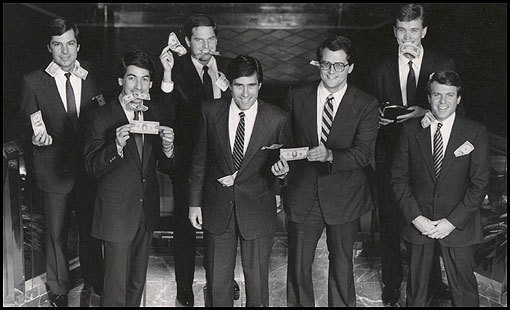Among U.S. scholars, none seem to casually elide more inconvenient truths than Charles Murray, who somehow claims to love both meritocracy and Sarah Palin. He can make solid sociological points, but he’s also a believer in American myths that were never quite true, especially if you weren’t a white male.
Murray argues in a WSJ essay that Donald Trump is benefiting from those who feel America is losing its national identity, which he says is rooted in three qualities: egalitarianism, liberty and individualism. Well, cross off the first two for large swaths of the population and even the third during long periods of our history when conformity was the norm. It’s big of Murray to acknowledge that “there are certainly elements of racism and xenophobia in Trumpism”–you don’t say, Chuck?–but he sees it as subplot rather than driving narrative.
His description of wealthy Americans “seceding from the mainstream” is limited by his blinders, but there is value in the passage. Citizens without money being thought of as “losers” is often a sad reality. Oddly enough, it’s very Trumpian.
An excerpt:
America also retained a high degree of social and cultural heterogeneity in its communities. Tocqueville wrote of America in the 1830s as a place where “the more opulent citizens take great care not to stand aloof from the people.” That continued well into the 20th century, even in America’s elite neighborhoods. In the 1960 census, the median income along Philadelphia’s Main Line was just $90,000 in today’s dollars. In Boston’s Brookline, it was $75,000; on New York’s Upper East Side, just $60,000. At a typical dinner party in those neighborhoods, many guests would have had no more than a high-school diploma.
In the years since, the new upper class has evolved a distinctive culture. For a half-century, America’s elite universities have drawn the most talented people from all over the country, socialized them and often married them off to each other. Brains have become radically more valuable in the marketplace. In 2016, a dinner party in those same elite neighborhoods consists almost wholly of people with college degrees, even advanced degrees. They are much more uniformly affluent. The current median family incomes for the Main Line, Brookline and the Upper East Side are about $150,000, $151,000 and $203,000, respectively.
And the conversation at that dinner party is likely to be completely unlike the conversations at get-togethers in mainstream America. The members of the new upper class are seldom attracted to the films, TV shows and music that are most popular in mainstream America. They have a distinctive culture in the food they eat, the way they take care of their health, their child-rearing practices, the vacations they take, the books they read, the websites they visit and their taste in beer. You name it, the new upper class has its own way of doing it.
Another characteristic of the new upper class—and something new under the American sun—is their easy acceptance of being members of an upper class and their condescension toward ordinary Americans. Try using “redneck” in a conversation with your highly educated friends and see if it triggers any of the nervousness that accompanies other ethnic slurs. Refer to “flyover country” and consider the implications when no one asks, “What does that mean?” Or I can send you to chat with a friend in Washington, D.C., who bought a weekend place in West Virginia. He will tell you about the contempt for his new neighbors that he has encountered in the elite precincts of the nation’s capital.
For its part, mainstream America is fully aware of this condescension and contempt and is understandably irritated by it. American egalitarianism is on its last legs.
While the new upper class was seceding from the mainstream, a new lower class was emerging from within the white working class, and it has played a key role in creating the environment in which Trumpism has flourished.•
Tags: Charles Murray, Donald Trump

